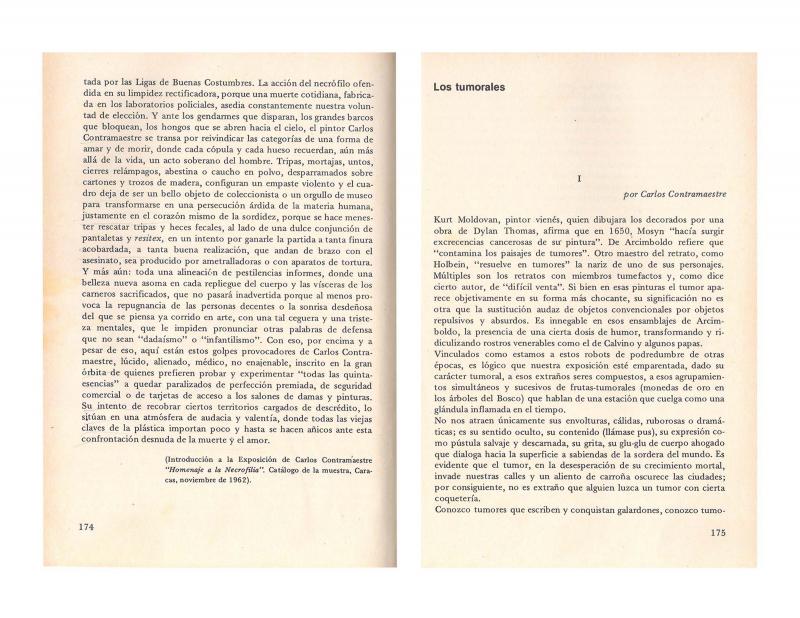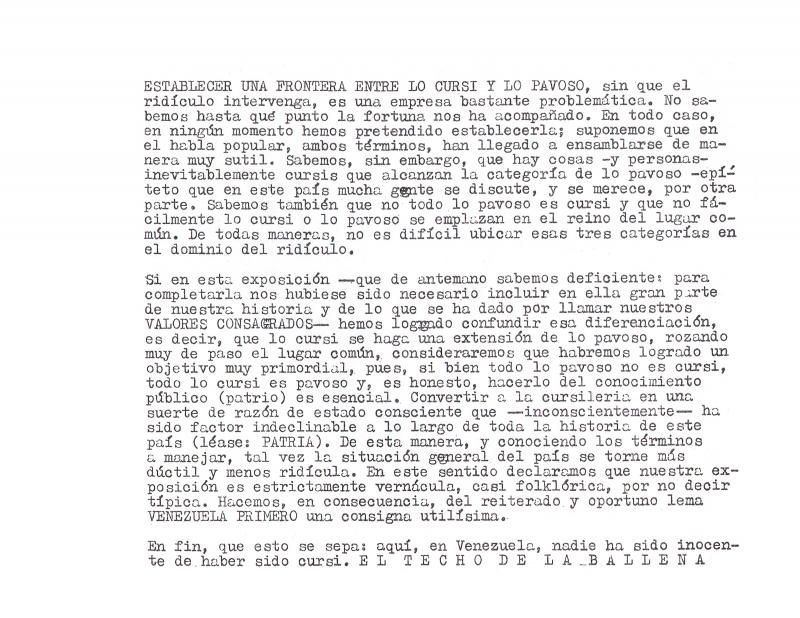This is a positive assessment of the activities of El Techo de la Ballena (Caracas, 1961–68) two years after the group was founded. The article includes a mention of the group’s major legacy to date, which consisted of having “really shaken up our lethargic cultural environment.” This is a constant theme throughout the article, which highlights the “Ballena’s” efforts to challenge movements and artists that represent enshrined artistic values in literature and the visual arts. The author of this article describes the “Ballena” as one of the “most spirited” movements of the time; however, beyond its persistent confrontation and provocation, he does not submit any arguments that classify the group as a “movement” with its own consistent, homogenous aesthetic that aspires to replace what it challenges. Perhaps the group’s voluntary and explicit decision to reject codes and canons—which is also mentioned in this article—prevented them from creating a movement in the traditional sense of the word. It is interesting to note the description the author provides at the beginning of his article: “though [El Techo de la Ballena] reflected no other real values;” that is, the author considers their provocative and combative activities to suffice in terms of a legacy. The “Ballena” group did not establish a “school” but their tireless experimentation in the visual arts, literature, and other media opened doors to subsequent advances by other avant-garde artists in Venezuela. El Techo de Ballena was a group of visual artists and writers from the Venezuelan avant-garde who from 1961 until 1968 combined a range of different disciplines—visual art, poetry, photography, film, and performance art, among others—to create a revolutionary form of art that challenged and contradicted every traditional socio-cultural value during the decade of greatest political violence that Venezuela had ever experienced: the 1960s. The group viewed guerrilla warfare, intellectual leftist ideas, repression, and cities devastated by the forced and accelerated developmental model of the country’s nascent democracy as their frame of reference. The visual artists in the group embraced informalism as their aesthetic, to which they added a potent shot of aggressiveness to counter the values of geometric abstraction, traditional landscape painting, and even social realism, and adopted a strategy that was subversive, provocative, irrational, and surreal. The group produced numerous publications—mainly, three issues of the magazine Rayado sobre el Techo—and provocative exhibitions. The main participants were Venezuelans: Carlos Contramaestre, Juan Calzadilla, Caupolicán Ovalles, Edmundo Aray, Francisco Pérez Perdomo, Salvador Garmendia, Adriano González León, Fernando Irazábal, Daniel González, Gabriel Morera, Gonzalo Castellanos, and Perán Erminy. There were also a few foreigners who lived in Venezuela: Dámaso Ogaz from Chile, and three Spaniards, J. M. Cruxent, Ángel Luque, and Antonio Moya. [To access other essays by members of El Techo de la Ballena, see in the ICAA digital archive by Adriano González León “Homenaje a la necrofilia” (doc. no. 1097543), his essay on love, death, and necrofilia—the introduction in the catalogue for Homenaje a la Necrofilia, Carlos Contramaestre’s exhibition at the Galería El Techo de la Ballena, Caracas in 1962; by Juan Calzadilla and Carlos Contramaestre “Los tumorales I y II” (doc. no. 1097559), in which they present the exhibition Los Tumorales, with works by Contramaestre, in 1963 at the Galería El Techo de la Ballena, Caracas; also by Adriano González León “Tercer manifiesto: ¿Por qué la ballena?” (doc. no. 1097576); and by Francisco Pérez Perdomo “(Sin título) [Hay ciertos rostros de la ciudad...]” (doc. no. 1060288). See also, by El Techo de la Ballena, “(Sin título) [Establecer una frontera entre lo cursi y lo pavoso...]” (doc. no. 1059586); “Para la restitución del magma” (doc. no. 1060710); “Las ‘Instituciones de cultura’ nos roban el oxígeno, afirman” (doc. no. 1060199); Rayado sobre el techo. Cambiar la vida, transformar la sociedad (doc. no. 1060254); and “Segundo manifiesto” (doc. no. 1057677)].









